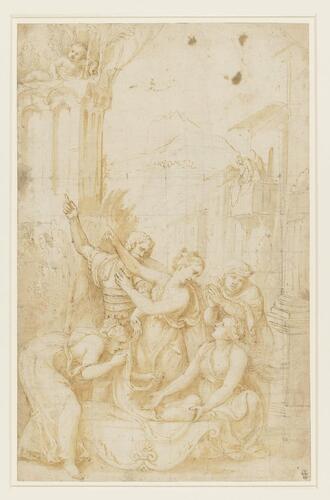-
1 of 253523 objects
An Omen of the Greatness of Augustus c.1536
Pen and ink with wash over charcoal underdrawing, squared in charcoal, the outlines partly incised | 37.4 x 23.9 cm (sheet of paper) | RCIN 990308

Giulio Romano (Rome c. 1499-Mantua 1546)
An Omen of the Greatness of Augustus c.1536
-
A drawing of five figures gathered around an empty crib, gesturing up at an infant on top of a tower. This is a study for the right-hand portion of a lost panel, originally installed below Titian's portrait of the Emperor Augustus in the Camerino dei Cesari of the Palazzo Ducale, Mantua. Like all twelve panels, the episode depicted is found in Suetonius's Lives of the Twelve Caesars – in this case in a chapter concerning the omens that occurred throughout Augustus's life (II, 94): 'When Augustus was still an infant, as is recorded by the hand of Gaius Drusus, he was placed by his nurse at evening in his cradle on the ground floor, and the next morning had disappeared; but after a long search he was at last found lying on a lofty tower with his face towards the rising sun.'
The panel of the Omen is lost, but three of the series survive in the Royal Collection (RCIN 402576, 402806, 406166) and one in the Louvre, and these establish that the panels were painted by members of Giulio's workshop and not by the master. The lost panels can be reconstructed from preparatory studies, prints after the designs, and a series of drawings of the walls by Ippolito Andreasi, now in Düsseldorf.
A study for the left half of the composition is in the Albertina (Birke & Kertesz 221). Put together, the two drawings would make an oblong composition, wider than tall. But the Andreasi copy shows that the panel was square, and that Giulio overlapped the designs seen in the Windsor and Vienna drawings to create the final composition. It is possible that the two sheets are fragments of a single large study, divided by Giulio during the preparatory process, and that the stylus indentations seen around the outlines of both drawings were used to combine the two halves into a more compact composition. But the present sheet is also squared, and without the evidence of all the drawings used in the creative process this apparent use of two independent transfer techniques cannot be fully explained.
The whole composition was engraved on a smaller scale by Giulio Bonasone (Bartsch XV, p.155, no. 174) in its original oblong format and thus from a preparatory drawing (or copy thereof) rather than from the painting; the same is true of a copy by Biagio Pupini at Christ Church, Oxford (Byam Shaw 468). A drawing of the composition at Besançon is a poor seventeenth-century copy after the print.
On a visit to Palazzo Bonfiglioli, Bologna in 1719, Jonathan Richardson saw framed: ‘Giulio. Five Figures and a Cradle; two pointing up to a Boy lying on a Ruin, Other Figures in the Sky, the same as one Dr Mead has of this Master, and that of Biaggio Bolog [Pupini] my Father has.’ That drawing was probably identical with an entry in the 1696 Bonfiglioli inventory: ‘Un disegno con Istoria o favola di mano di Giulio Romano con cornice, e cassetta dorata, e vetro.’ The number of figures stated by Richardson corresponds with the present drawing, and it is likely that this was the sheet seen by him in Bologna. However he also noted on his father's copy of the whole composition by Pupini, now at Christ Church: ‘The Original Design of this is in the Collection of Bonfiglioli at Bologna; 'tis of Giulio Romano. Dr Mead has a Sketch with a Pen of a part of it’, which implies – probably misleadingly – that he had seen the full composition in Bologna.Provenance
Probably Bonfiglioli family, Bologna, by 1696; from whom purchased by Zaccaria Sagredo, 1728; from whose heirs purchased by Joseph Smith, 1752; from whom purchased by George III, 1762. Not identified in George III's 'Inventory A' of c.1810.
-
Medium and techniques
Pen and ink with wash over charcoal underdrawing, squared in charcoal, the outlines partly incised
Measurements
37.4 x 23.9 cm (sheet of paper)
Object type(s)